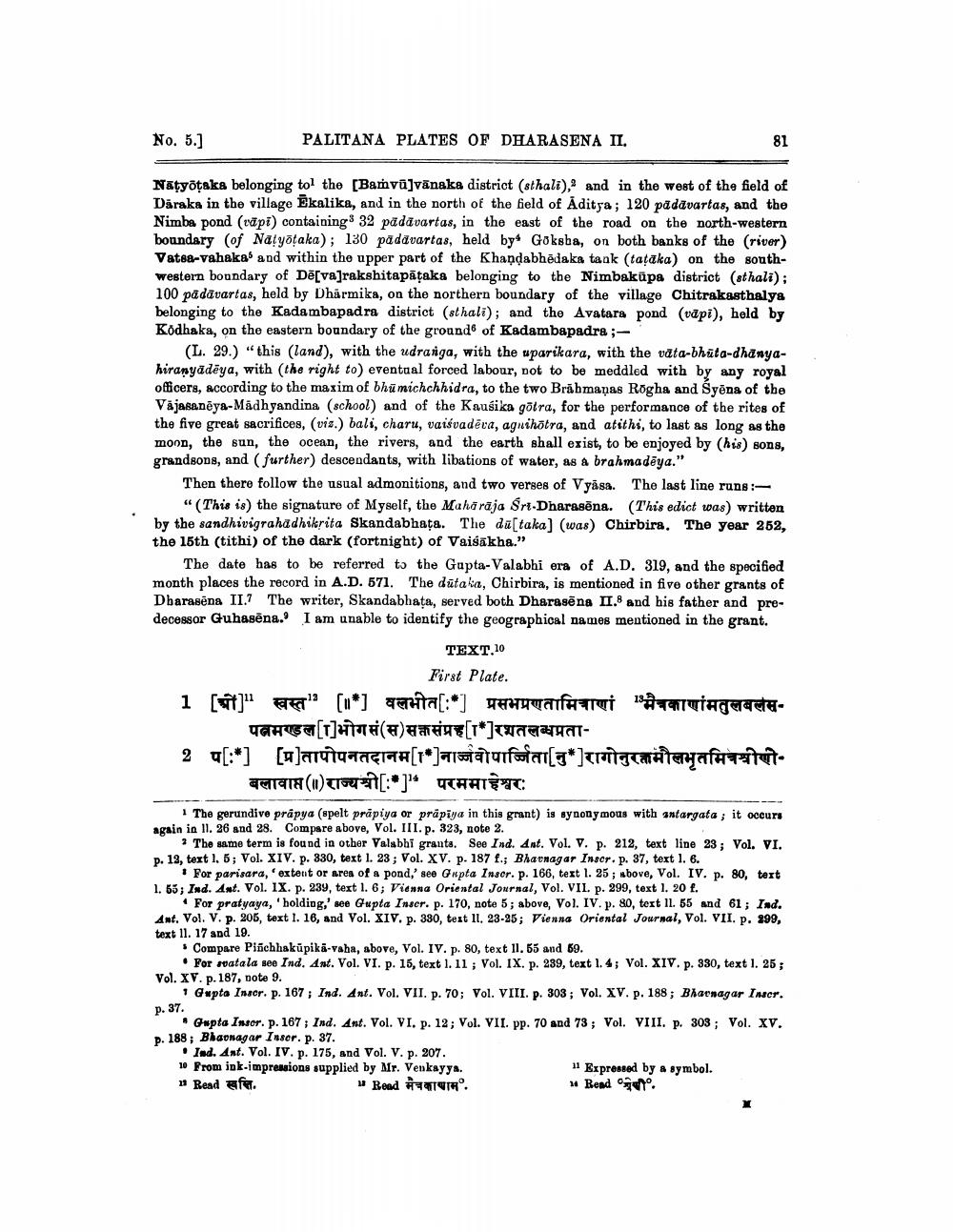________________
No. 5.]
Natyōṭaka belonging to the [Bamvū]vānaka district (sthali), and in the west of the field of Daraka in the village Ekalika, and in the north of the field of Aditya; 120 padavartas, and the Nimba pond (vapi) containing3 32 padavartas, in the east of the road on the north-western boundary (of Natyōṭaka); 130 pädävartas, held by Goksha, on both banks of the (river) Vatsa-vahaka' and within the upper part of the Khandabhēdaka tank (taṭaka) on the southwestern boundary of De[va]rakshitapataka belonging to the Nimbakupa district (sthali); 100 pādāvartas, held by Dharmika, on the northern boundary of the village Chitrakasthalya belonging to the Kadambapadra district (sthali); and the Avatara pond (vapi), held by Ködhaka, on the eastern boundary of the ground of Kadambapadra ;
PALITANA PLATES OF DHARASENA II.
(L. 29.) "this (land), with the udranga, with the uparikara, with the vata-bhūta-dhanyahiranyādēya, with (the right to) eventual forced labour, not to be meddled with by any royal officers, according to the maxim of bhumichchhidra, to the two Brahmanas Rogha and Syena of the Vajasaneya-Madhyandina (school) and of the Kausika götra, for the performance of the rites of the five great sacrifices, (viz.) bali, charu, vaiśvadeva, agnihotra, and atithi, to last as long as the moon, the sun, the ocean, the rivers, and the earth shall exist, to be enjoyed by (his) sons, grandsons, and (further) descendants, with libations of water, as a brahmadēya."
81
Then there follow the usual admonitions, and two verses of Vyasa.
The last line runs :"(This is) the signature of Myself, the Maharaja Sri-Dharasena. (This edict was) written by the sandhivigrahadhikrita Skandabhața. The du[taka] (was) Chirbira. The year 252, the 15th (tithi) of the dark (fortnight) of Vaisakha."
The date has to be referred to the Gupta-Valabhi era of A.D. 319, and the specified month places the record in A.D. 571. The dutaka, Chirbira, is mentioned in five other grants of Dharasena II. The writer, Skandabhata, served both Dharasena II.8 and his father and predecessor Guhasena. I am unable to identify the geographical names mentioned in the grant.
TEXT.10 First Plate.
स्वस्त" [1] वलभीत[: *] प्रसभप्रणतामित्राणां "मैत्रकाणां मतुलवलसपनमण्डल [T]भोग सं (स) सक्तसंग्रह [[*] रशतलब्धप्रता
2 [:*] [प्र] तापोपनतदानम [1*] नाज्जैवोपार्ज्जिता[नु* ] रागोनुरक्तमौलभृतमित्रश्रीणी
बलावात (1) राज्यची [:]"
परममाहेश्वरः
1 []" स्वस्त "
[]
1 The gerundive präpya (spelt prapiya or prapiya in this grant) is synonymous with antargata; it occurs again in 11. 26 and 28. Compare above, Vol. III. p. 323, note 2.
2 The same term is found in other Valsbhi grants. See Ind. Ant. Vol. V. p. 212, text line 23; Vol. VI. p. 13, text 1. 5; Vol. XIV. p. 330, text 1. 23; Vol. XV. p. 187 f.; Bhavnagar Inser. p. 37, text 1. 6.
For parisara,' extent or area of a pond,' see Gupta Inser. p. 166, text 1. 25; above, Vol. IV. p. 80, text
1. 55; Ind. Ant. Vol. IX. p. 239, text 1. 6; Vienna Oriental Journal, Vol. VII. p. 299, text 1. 20 f.
For pratyaya, 'holding,' see Gupta Inser. p. 170, note 5; above, Vol. IV. p. 80, text 11. 55 and 61; Ind. Ant. Vol. V. p. 205, text 1. 16, and Vol. XIV. p. 330, text 11. 23-25; Vienna Oriental Journal, Vol. VII. p. 299, text 11. 17 and 19.
• Compare Piñchhakupika-vaha, above, Vol. IV. p. 80, text 11. 55 and 59.
• For svatala see Ind. Ant. Vol. VI. p. 15, text 1. 11; Vol. IX. p. 239, text 1.4; Vol. XIV. p. 330, text 1. 25; Vol. XV. p. 187, note 9.
1 Gupta Inser. p. 167; Ind. Ant. Vol. VII. p. 70; Vol. VIII. p. 303; Vol. XV. p. 188; Bhavnagar Inser.
p. 37.
Gupta Inser. p. 167; Ind. Ant. Vol. VI. p. 12; Vol. VII. pp. 70 and 73; Vol. VIII. p. 303; Vol. XV. p. 188; Bhavnagar Inser. p. 37.
Ind. Ant. Vol. IV. p. 175, and Vol. V. p. 207. 10 From ink-impressions supplied by Mr. Venkayya. 12 Read af. Read मैत्रकायाम.
11 Expressed by a symbol. 14 Bead
.




